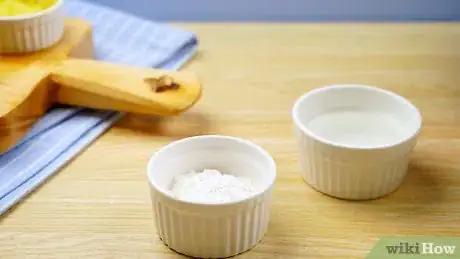This article was co-authored by Katie Hake RDN, LD and by wikiHow staff writer, Megaera Lorenz, PhD. Katie Hake is a Registered Dietitian, Licensed Nutritionist, Fitness Professional and the Owner of Katie Hake Health & Fitness, LLC. She specializes in constructing sustainable life changes in health and fitness. Katie received a dual degree BS in Dietetics and Nutrition & Fitness and Health from Purdue University.
There are 7 references cited in this article, which can be found at the bottom of the page.
This article has been viewed 106,475 times.
It can be tough to achieve the perfect consistency when making a sauce. Luckily, most kitchens are stocked with an effective and time-tested thickening agent—flour. For a quick and easy approach, just mix raw flour with a little cold water and whisk it into your sauce as you cook. With a bit of extra effort, you can create an especially luscious and creamy sauce by mixing flour and fat to create a roux.
Steps
Adding a Flour Slurry to the Sauce
-
1Mix a little flour and water in a bowl. Use 2 tablespoons (about 16-18 grams) of flour and .25 cups (59 mL) of water for every 1 cup (240 mL) of sauce. Mix the water and flour carefully, making sure that there are no lumps.[1]
- Be sure to use cold water, since warm or hot water will cause the flour to clump together.
- If you want a thicker sauce, add a little more flour. Use less flour for a thinner sauce.
-
2Stir the flour and water combination into your sauce. Once the flour and water are thoroughly mixed, slowly pour this mixture (called a slurry) into the sauce.[2] Keep stirring or whisking as you pour to prevent clumps from forming.[3]
- Make sure the slurry is thoroughly mixed into the sauce to create an even thickness.
Advertisement -
3Cook the sauce over medium heat until it thickens. After mixing in the slurry, allow the sauce to cook until it becomes bubbly. You should also notice the sauce becoming thicker. Keep stirring as the sauce continues to cook to prevent burning.[4]
- The sauce will thicken a little more after it cools, so aim for getting it just shy of how thick you want it. You may need to experiment a bit to achieve the texture you want.
-
4Let the sauce cook 1 more minute after it thickens. Keep checking the sauce as it cooks to see if it has achieved the desired thickness. After that, give it an additional minute to cook before taking it off the heat. This will give the flour time to cook thoroughly so that your sauce doesn’t have a strong raw flour flavor.[5]
- Allowing the sauce to reach a full boil after adding the slurry can also help cook off the flour flavor.[6] Take care not to let your sauce burn, however!
Thickening Creamy Sauces with Roux
-
1Choose a fat that’s right for your roux. The type of fat you choose will affect the flavor and texture of your sauce, so take this into account before you start cooking. The common options include:[7]
- Butter, for a rich and creamy flavor. This is a good choice for cream-based sauces, like bechamel or alfredo.
- Animal fat, such as bacon or pork drippings. This will impart a meaty or sausage-like flavor, so choose this option for gumbos and other Creole dishes.
- Vegetable oil. This is the most neutral option, flavor-wise. It’s also less likely to burn than butter-based roux and is a vegan-friendly choice.
-
2Mix together equal parts flour and fat in a saucepan. Use 2 tablespoons (30 mL) of fat and 2 tablespoons (about 16-18 grams) of flour for every 1 cup (240 mL) of sauce, or a little more flour for a thicker sauce. Stir the fat and flour together with a long-handled wooden spoon until they are thoroughly combined.[8]
- If you’re using a hard fat, like butter, melt it in the pan first and then stir the butter in.
-
3Cook the mixture over medium-low heat, stirring constantly. Once you’ve mixed your ingredients together, begin cooking the roux. You will need to keep stirring in order to prevent the roux from burning.[9] It’s especially easy to scorch butter-based roux, so keep a close eye on your pot as you cook.
- You can ensure even cooking by stirring in a figure-8 pattern.[10]
-
4Let the roux cook until it reaches the desired color. The longer you cook your roux, the darker it will become. Darker roux has a more toasty and complex flavor, but it is also less effective at thickening than a lighter roux.[11]
- Cook for 3-5 minutes for a light roux, which is good for sauces like bechamel or white gravy.[12] A light roux should be cooked enough to lose the characteristic raw flour taste and smell, but not long enough that it begins to brown.
- For brown roux, cook for 6-7 minutes. This is an ideal roux for brown gravy.[13]
- If you want dark roux, let your mixture cook for 8-15 minutes. This is a good option for Cajun and Creole sauces.[14]
-
5Allow the roux to cool before combining it with your sauce. When your roux is cooked to the desired color, remove it from the heat and let it sit for a while. You can use it once it is warm to the touch (as opposed to hot) or even refrigerate it and use it cold.[15]
- If you add the roux to a cooler sauce while it is still bubbling hot, it will break apart and form clumps.
- As a general rule, it’s best to combine roux and the rest of your sauce when they are at similar temperatures. For example, if haven’t started heating your sauce yet, add the roux while both are cold or lukewarm.
-
6Whisk the roux into your sauce and let it simmer for at least 20 minutes. Once your roux is cooled, stir it gradually into your sauce. Make sure to mix it thoroughly so that the sauce thickens evenly. Allow the mixture to simmer for 20 minutes or longer so that any residual flour flavor is cooked out.[16]
- During the simmering process, fat or oil may rise to the top of the sauce. Use a spoon to skim it off.
Community Q&A
-
QuestionWhat can I use to thicken sauce?
 Drew Hawkins1Community AnswerYou can use flour as a quick and easy way to thicken up a sauce. Make a simple flour slurry by combining 2 tablespoons (about 16-18 grams) of flour and .25 cups (59 mL) of water for every 1 cup (240 mL) of sauce. Stir the flour slurry to combine it well and then stir it gently into your sauce. Cook the sauce on medium heat until it reaches your desired thickness.
Drew Hawkins1Community AnswerYou can use flour as a quick and easy way to thicken up a sauce. Make a simple flour slurry by combining 2 tablespoons (about 16-18 grams) of flour and .25 cups (59 mL) of water for every 1 cup (240 mL) of sauce. Stir the flour slurry to combine it well and then stir it gently into your sauce. Cook the sauce on medium heat until it reaches your desired thickness. -
QuestionDoes simmering thicken sauce?
 Drew Hawkins1Community AnswerYes, simmering does work to thicken a sauce. As the liquid cooks and simmers, the water is cooked and evaporated away. That makes caused the sauce left behind to get thicker and thicker as the amount of water gets lower and lower. Keep the heat low so the sauce doesn't burn and let it simmer until it's as thick as you want it to be.
Drew Hawkins1Community AnswerYes, simmering does work to thicken a sauce. As the liquid cooks and simmers, the water is cooked and evaporated away. That makes caused the sauce left behind to get thicker and thicker as the amount of water gets lower and lower. Keep the heat low so the sauce doesn't burn and let it simmer until it's as thick as you want it to be. -
QuestionIs it better to thicken with flour or cornstarch?
 Drew Hawkins1Community AnswerActually, both flour and cornstarch are great thickening agents. But, because cornstarch is a pure starch, it has about twice the thickening power of flour. If you need to really thicken up a sauce or soup, reach for the cornstarch. If you need just a bit of thickening, using flour may be your best option. It all depends on your needs and what you happen to have in your kitchen.
Drew Hawkins1Community AnswerActually, both flour and cornstarch are great thickening agents. But, because cornstarch is a pure starch, it has about twice the thickening power of flour. If you need to really thicken up a sauce or soup, reach for the cornstarch. If you need just a bit of thickening, using flour may be your best option. It all depends on your needs and what you happen to have in your kitchen.
Warnings
- While it may be tempting to dump a little flour directly into your sauce, this will only result in clumps and frustration. Making a slurry or roux separates the flour granules and helps distribute them more evenly through the sauce.⧼thumbs_response⧽
References
- ↑ https://www.bhg.com/recipes/how-to/cooking-basics/thickening-with-cornstarch-or-flour/
- ↑ https://www.bhg.com/recipes/how-to/cooking-basics/thickening-with-cornstarch-or-flour/
- ↑ https://www.thekitchn.com/quick-tip-how-to-make-and-use-73081
- ↑ https://www.bhg.com/recipes/how-to/cooking-basics/thickening-with-cornstarch-or-flour/
- ↑ https://www.bhg.com/recipes/how-to/cooking-basics/thickening-with-cornstarch-or-flour/
- ↑ https://www.reluctantgourmet.com/beef-stew-tastes-doughy/
- ↑ https://www.seriouseats.com/2018/05/a-brief-guide-to-roux.html
- ↑ https://www.bhg.com/recipes/how-to/cooking-basics/how-to-make-roux/
- ↑ https://www.bhg.com/recipes/how-to/cooking-basics/how-to-make-roux/
- ↑ https://www.foodnetwork.com/how-to/articles/how-to-make-a-roux-a-step-by-step-guide
- ↑ https://www.seriouseats.com/2018/05/a-brief-guide-to-roux.html
- ↑ https://www.foodnetwork.com/how-to/articles/how-to-make-a-roux-a-step-by-step-guide
- ↑ https://www.foodnetwork.com/how-to/articles/how-to-make-a-roux-a-step-by-step-guide
- ↑ https://www.foodnetwork.com/how-to/articles/how-to-make-a-roux-a-step-by-step-guide
- ↑ https://stellaculinary.com/cooking-videos/sauces-soups/sns-007-how-make-and-use-roux
- ↑ https://stellaculinary.com/cooking-videos/sauces-soups/sns-007-how-make-and-use-roux
About This Article
To thicken up your sauce with a simple flour slurry, mix flour with cold water in a bowl. Stir the mixture thoroughly until it’s smooth and free of lumps. Slowly pour the slurry into your sauce while it’s still cold, stirring constantly to achieve an even consistency. Cook the sauce over medium heat until it begins to bubble and thicken. Keep stirring so the sauce doesn’t stick to the pan or burn. Once it’s slightly runnier than the desired thickness, let the sauce cook for 1 more minute, then take it off the heat. It will continue to thicken slightly as it cools. To learn how to thicken creamy sauces with a roux made of flour and fat, keep reading!























































